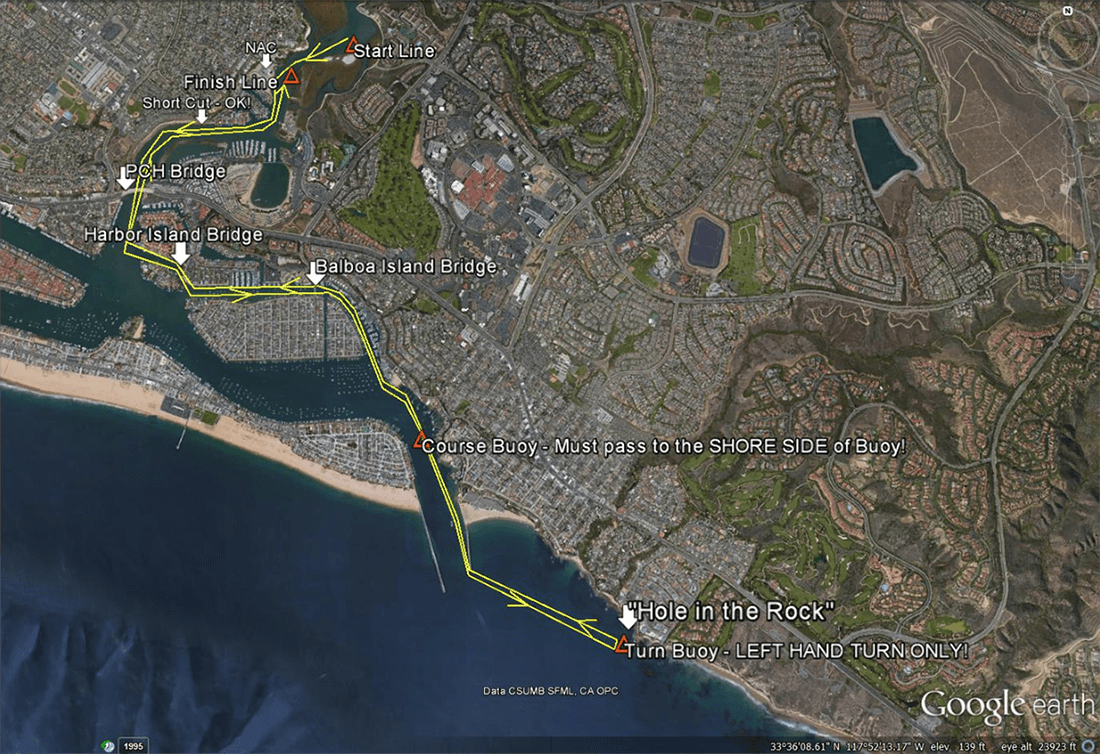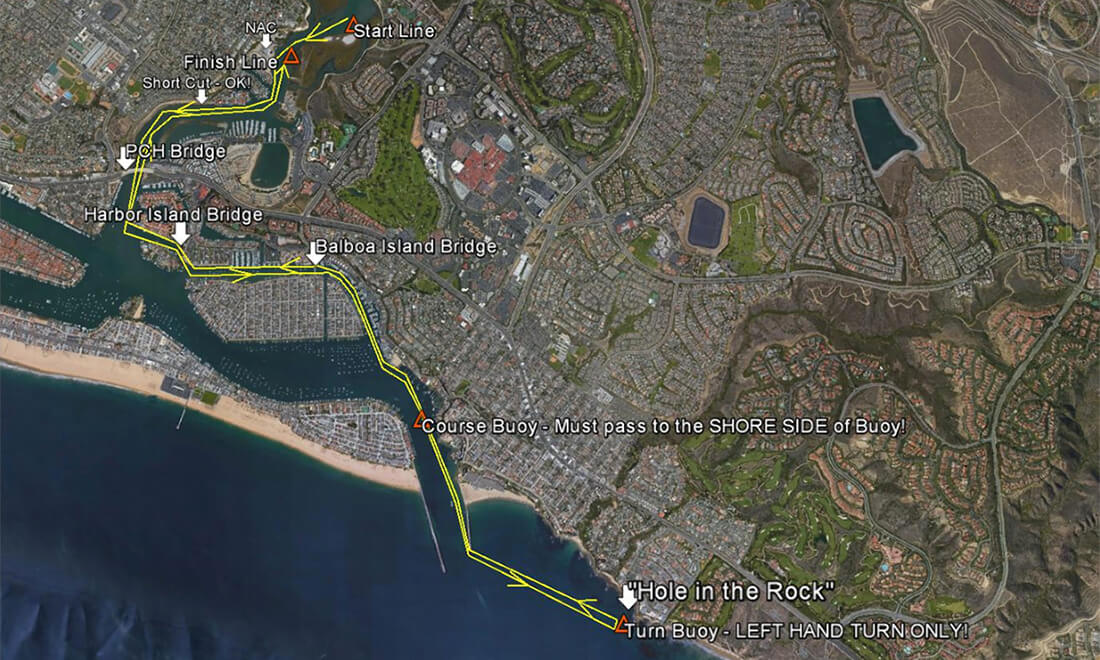February 7, 2019 by Austin Kieffer
The NAC Classic falls almost perfectly 5 weeks after my first session of 2019. I chose to compete in this race for three reasons. First, it is a flatter race and due to the colder weather in San Fran and avoiding rougher conditions for my shoulder, I have been focusing my early season on flatwater technique, efficiency, and aerobic base. Second, 5 weeks into the season is the perfect amount of time to not be embarrassingly unfit, but just enough to make racing extremely challenging. Third, the NAC Classic is a race that I have participated in twice before and I have competed many times against all the attending athletes, so it will be an excellent gauge of my current fitness.
 The race itself is a two event format. First, there is a long course consisting of 18 kilometers of mostly protected flatwater in Newport Harbor with two kilometers of exposed ocean in the middle of the race. After completing the long course, there will be a break of approximately one hour before the start of the short course. The short course will be a 7-kilometer race in completely flat and protected water.
The race itself is a two event format. First, there is a long course consisting of 18 kilometers of mostly protected flatwater in Newport Harbor with two kilometers of exposed ocean in the middle of the race. After completing the long course, there will be a break of approximately one hour before the start of the short course. The short course will be a 7-kilometer race in completely flat and protected water.
In years past, I have welcomed the challenge of competing in two events back to back. The long course is the more important in my mind, but the short course often proves more challenging, because many athletes race their K1s and I often am acutely aware of the toll the prior 18km took on my body. This year will be the same only doubly challenging. So far this year, intensity has been near absent in my training and I have focused on aerobic base and sub-race pace intervals of 5-10 minutes. Nothing approaching race pace and certainly nothing close to the pace I expect at the start, but to me, that makes the race all the more exciting!
One of my all-time favorite things about surfski racing is the tactics of a good race. This year, more than ever my tactics will be pivotal to my racing success. Tim Burdiak has been dominating the SoCal series so far and as a Surf Life Saving World Champion, he is definitely the man to beat on Saturday. Along with him, Jesse Lishchuk, Nate Errez and a host of other sprint athletes will be competing in both events. To win, I will need to exploit every advantage I have and predicting the race dynamics is a big advantage in my mind. Below is my guess of how the race will unfold, based on prior years and a look at the current startlist.
The start will be fast. With so many sprint athletes and a lot of young ego on the line, I would say the start will be reckless. The frenetic pace will shed athletes quickly and I think that within the first 5 minutes there will be a lead pack of about 4-5 paddlers. From there, it will become all about draft pack tactics. I would imagine that a few of the athletes will take strong pulls, some to posture and display control, others to tactically exploit weakness in the group. During the subsequent 20-30 minutes, the pack will slowly shed and drop to a group of 2 to 4 paddlers. When the race hits the ocean around the halfway point, the flatwater specialists will suffer a little and the final separations will occur. I would say that those with more ocean experience will earn a sizable gap but I don't think there will be a single athlete breakaway. I doubt that anyone will want to lead 8 km of flatwater alone (unless they have a clear fitness advantage). My guess is that whoever is leading out of the ocean will let nearby athletes catch up. The reason being that any small mistake with line choice could allow trailing competitors to catch and negate all the effort put into a breakaway. Also, if a few chasing athletes group up, it will be much easier for them to reel in the leader. I think the line honors will not be decided until the final kilometer or few hundred meters of finish sprint.
So what does that mean for me?
For me, a race always starts in the warm-up. One of the most useful racing tips I was ever given was a tip from Jasper Mocke telling me to always mark my competition at the start. He said, “line up against the person you want to beat and don’t let them get away, even if they try to get away before the start whistle”. In a sport notorious for creeping lines and acceptable false starts, it really is your own fault if you are left behind when your competition starts going. In a flatter event like this, being able to link onto someone’s draft or catch the wash of a fast double right away can make or break your race. On Saturday, I will be lining up with Tim. In my mind, he is the man to beat and I do not want to let him get away off the line. I expect the lead pack to be pulled into an aggressive start with many of the sprinters burning early matches. Everyone has different opinions about the start, but my philosophy is: do as little work as possible to stay in contact with the leaders. Letting your ego run rampant (as mine most certainly has in races past) can lead to an impressive first ten minutes and a miserable subsequent seventy.
After weathering the start, my goal is to settle into the lead pack. I will, of course, do my fair share of work at the front, but any unnecessary sprinting or wasted energy could cost me the line honors at the end. I will focus on breathing and anticipating moves from my competition to try and stay as efficient and conservative when not pulling. I won't think about making a move until the ocean. Once there, I will try to push for a little separation, milking any bump or chop I can find. I will, however, make sure not to find myself in no man's land coming out of the ocean. If I am leading I will back off a little and if I am behind, I will try to smoothly notch it up to catch the leader. For the next 7 kilometers, I will try to return to efficiency and conserve until the final (and hopefully winning) move in the last kilometer. I don’t want it to come down to a turn of pace at the end, so I will try to do this before we actually see the finish line (hopefully Tim, Jesse and Nate are not reading this before race day, haha).
For the short course, I will try my best to stay warm and keep my body from cooling down and tightening up. I will fuel up as much as my stomach will accept, and honestly, I will work with whatever I have left in the short course. I have no aspirations or strategies for race two. I intend to merely give it my all and suffer to the best of my ability (without jeopardizing my shoulder health).
Thanks for reading and if you enjoyed the read, I look forward to telling you how it went on Sunday!

2/9/19
Hal Rosoff Classic
This year the 23rd Annual NAC Hal Rosoff Classic on February 9, 2019!
The Hal Rosoff Classic is a paddling race in Newport Harbor consisting of a short and long course for Outriggers, Kayaks, Prone, K1’s, C1’s and Stand Up Paddle Boards. The annual race is in the second week of February and attracts between 300-400 participants from Southern California. Proceeds benefit the NAC Outrigger program

The NAC Classic falls almost perfectly 5 weeks after my first session of 2019. I chose to compete in this race for three reasons. First, it is a flatter race and due to the colder weather in San Fran and avoiding rougher conditions for my shoulder, I have been focusing my early season on flatwater technique, efficiency, and aerobic base. Second, 5 weeks into the season is the perfect amount of time to not be embarrassingly unfit, but just enough to make racing extremely challenging. Third, the NAC Classic is a race that I have participated in twice before and I have competed many times against all the attending athletes, so it will be an excellent gauge of my current fitness.
The race itself is a two event format. First, there is a long course consisting of 18 kilometers of mostly protected flatwater in Newport Harbor with two kilometers of exposed ocean in the middle of the race. After completing the long course, there will be a break of approximately one hour before the start of the short course. The short course will be a 7-kilometer race in completely flat and protected water.
In years past, I have welcomed the challenge of competing in two events back to back. The long course is the more important in my mind, but the short course often proves more challenging, because many athletes race their K1s and I often am acutely aware of the toll the prior 18km took on my body. This year will be the same only doubly challenging. So far this year, intensity has been near absent in my training and I have focused on aerobic base and sub-race pace intervals of 5-10 minutes. Nothing approaching race pace and certainly nothing close to the pace I expect at the start, but to me, that makes the race all the more exciting!
One of my all-time favorite things about surfski racing is the tactics of a good race. This year, more than ever my tactics will be pivotal to my racing success. Tim Burdiak has been dominating the SoCal series so far and as a Surf Life Saving World Champion, he is definitely the man to beat on Saturday. Along with him, Jesse Lishchuk, Nate Errez and a host of other sprint athletes will be competing in both events. To win, I will need to exploit every advantage I have and predicting the race dynamics is a big advantage in my mind. Below is my guess of how the race will unfold, based on prior years and a look at the current startlist.
The start will be fast. With so many sprint athletes and a lot of young ego on the line, I would say the start will be reckless. The frenetic pace will shed athletes quickly and I think that within the first 5 minutes there will be a lead pack of about 4-5 paddlers. From there, it will become all about draft pack tactics. I would imagine that a few of the athletes will take strong pulls, some to posture and display control, others to tactically exploit weakness in the group. During the subsequent 20-30 minutes, the pack will slowly shed and drop to a group of 2 to 4 paddlers. When the race hits the ocean around the halfway point, the flatwater specialists will suffer a little and the final separations will occur. I would say that those with more ocean experience will earn a sizable gap but I don't think there will be a single athlete breakaway. I doubt that anyone will want to lead 8 km of flatwater alone (unless they have a clear fitness advantage). My guess is that whoever is leading out of the ocean will let nearby athletes catch up. The reason being that any small mistake with line choice could allow trailing competitors to catch and negate all the effort put into a breakaway. Also, if a few chasing athletes group up, it will be much easier for them to reel in the leader. I think the line honors will not be decided until the final kilometer or few hundred meters of finish sprint.
So what does that mean for me?
For me, a race always starts in the warm-up. One of the most useful racing tips I was ever given was a tip from Jasper Mocke telling me to always mark my competition at the start. He said, “line up against the person you want to beat and don’t let them get away, even if they try to get away before the start whistle”. In a sport notorious for creeping lines and acceptable false starts, it really is your own fault if you are left behind when your competition starts going. In a flatter event like this, being able to link onto someone’s draft or catch the wash of a fast double right away can make or break your race. On Saturday, I will be lining up with Tim. In my mind, he is the man to beat and I do not want to let him get away off the line. I expect the lead pack to be pulled into an aggressive start with many of the sprinters burning early matches. Everyone has different opinions about the start, but my philosophy is: do as little work as possible to stay in contact with the leaders. Letting your ego run rampant (as mine most certainly has in races past) can lead to an impressive first ten minutes and a miserable subsequent seventy.
After weathering the start, my goal is to settle into the lead pack. I will, of course, do my fair share of work at the front, but any unnecessary sprinting or wasted energy could cost me the line honors at the end. I will focus on breathing and anticipating moves from my competition to try and stay as efficient and conservative when not pulling. I won't think about making a move until the ocean. Once there, I will try to push for a little separation, milking any bump or chop I can find. I will, however, make sure not to find myself in no man's land coming out of the ocean. If I am leading I will back off a little and if I am behind, I will try to smoothly notch it up to catch the leader. For the next 7 kilometers, I will try to return to efficiency and conserve until the final (and hopefully winning) move in the last kilometer. I don’t want it to come down to a turn of pace at the end, so I will try to do this before we actually see the finish line (hopefully Tim, Jesse and Nate are not reading this before race day, haha).
For the short course, I will try my best to stay warm and keep my body from cooling down and tightening up. I will fuel up as much as my stomach will accept, and honestly, I will work with whatever I have left in the short course. I have no aspirations or strategies for race two. I intend to merely give it my all and suffer to the best of my ability (without jeopardizing my shoulder health).
Thanks for reading and if you enjoyed the read, I look forward to telling you how it went on Sunday!

2/9/19
Hal Rosoff Classic
This year the 23rd Annual NAC Hal Rosoff Classic on February 9, 2019!
The Hal Rosoff Classic is a paddling race in Newport Harbor consisting of a short and long course for Outriggers, Kayaks, Prone, K1’s, C1’s and Stand Up Paddle Boards. The annual race is in the second week of February and attracts between 300-400 participants from Southern California. Proceeds benefit the NAC Outrigger program

